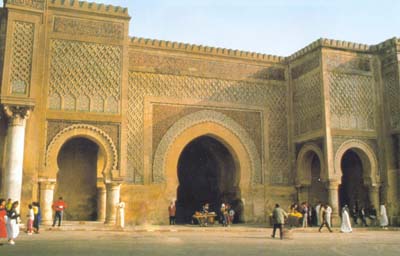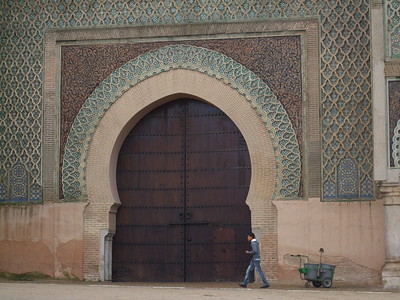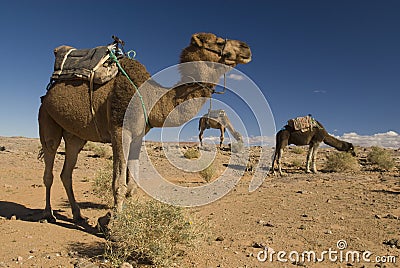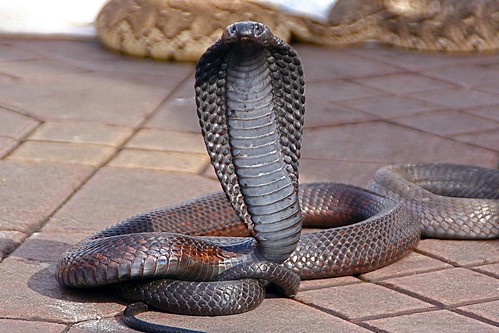Obligatory point of passage between the Atlantic plains and highlands Oriental, on the one hand, and between the Middle Atlas and hills Septentrional pre-Rif, on the other hand, Meknes occupies a very strategic position. In addition to this location, the region offers significant economic potential: the fertile plains of Sais, the abundance of water resources, oaks Atlas, all factors conducive to human settlement and communication passage for so long.
In the absence of archaeological evidence, it is reasonable to believe, according to some written sources, the earliest human settlements in the region of Meknes could go back to the 4th century BC.
Moreover, according to the written sources, the name appears only in Meknes 9th centuries, with the installation of a group of Berber Zénètes Meknassa, around wadis and Boufekrane Wislane.
At the Almohad period until the end of the 11th century, the name of az-Zaitoun Meknassata (Meknès olive) appointed yet ethnic groups and rural dwellers of various origins: Berber Sahara Berber Zénètes and Idrissides.

This influx of people has resulted in a significant economic and urban development, resulting in the appearance of urban areas, the construction of the Almoravid fortress Tagrart considered the core of the city of Meknes, Nejjarine Mosque, the mosque ... Sebbaghine
At the Almohad period, Meknes knew the establishment of public utility buildings such as: public baths, water supply channel sources, the expansion of the Grand Mosque and the development of fiscal institutions.
 The period is marked by the Merinid interest in mental institutions, religious and social. Therefore, several buildings have emerged: Library of the great mosque, madrasas Filalia and Bouanania, Jamaa Mosque Lalla Aouda, Jamaa Mosque Az-Zarqa, fountains, Maristane, bridges, zaouia and mausoleums.
The period is marked by the Merinid interest in mental institutions, religious and social. Therefore, several buildings have emerged: Library of the great mosque, madrasas Filalia and Bouanania, Jamaa Mosque Lalla Aouda, Jamaa Mosque Az-Zarqa, fountains, Maristane, bridges, zaouia and mausoleums.The Alawite time is very significant. Meknes was the capital of the country. Sultan Moulay Ismail the bestowed several buildings worthy of a modern capital at the height of his hopes: Dome of Ambassadors, and Silôts Swani Basin (Heri) Stables capacity of 1200 horse, green spaces Jnan Ben Hlima, prisons Qara. He also surrounded by walls 40 km in length, drilled 20 gates fortified towers and bastions (Lekhmis Bab, Bab Bardaïne, Bab al-Mansour, Kari Bordj Ben ect ..). In addition to its military pronounced the medina of Meknes has flourished within its walls, then Alawite, giving rise to numerous buildings: palaces (Ksar al-Mhencha, Dar Kbira, Ksar al- Mansour, Ksar Baïda ....), religious institutions, mosques and madrasas, public squares, fountains and jardins.Point gateway between the Atlantic plains and highlands Oriental, on the one hand, and between the Middle Atlas Septentrional and pre-Rif hills, on the other hand, Meknes occupies a very strategic position. In addition to this location, the region offers significant economic potential: the fertile plains of Sais, the abundance of water resources, oaks Atlas, all factors conducive favorite human settlement and communication passage for so long.

In the absence of archaeological evidence, it is reasonable to believe, according to some written sources, the earliest human settlements in the region of Meknes could go back to the 4th century BC.
Moreover, according to the written sources, the name appears only in Meknes 9th centuries, with the installation of a group of Berber Zénètes Meknassa, around wadis and Boufekrane Wislane.
At the Almohad and up to the late 11th century, the name Meknassata az-Zaitoun (Meknès olive) appointed yet ethnic groups and rural dwellers of various origins: Berber Sahara Berber Zénètes and Idrissides.
This influx of people resulted á economic development and urban notable results in the appearance of urban areas, the construction of the Almoravid fortress Tagrart considered the core of the city of Meknes, Nejjarine Mosque, the mosque ... Sebbaghine

At the Almohad period, Meknes knew the establishment of public utility buildings such as: public baths, water supply channel sources, the expansion of the Grand Mosque and the development of fiscal institutions.
The period is marked by the Merinid interest in mental institutions, religious and social. Therefore, several buildings have emerged: Library of the great mosque, madrasas Filalia and Bouanania, Jamaa Mosque Lalla Aouda, Jamaa Mosque Az-Zarqa, fountains, Maristane, bridges, zaouia and mausoleums.
 The Alawite time is very significant. Meknes was the capital of the country. Sultan Moulay Ismail the bestowed several buildings worthy of a modern capital á up to its expectations: Ambassadors Dome, Basin and Silôts Swani (Heri) Stables capacity of 1200 horse, green spaces Jnan Ben Hlima, prisons Qara. He also surrounded by walls 40 km in length, drilled 20 gates fortified towers and bastions (Lekhmis Bab, Bab Bardaïne, Bab al-Mansour, Kari Bordj Ben ect ..). In addition to its military pronounced the medina of Meknes has flourished favorite within its walls, Alawite time favorite for lead á many buildings: palaces (Ksar al-Mhencha, Dar Kbira, Ksar al- Mansour, Ksar Baïda ....), religious institutions, mosques and madrasas, public squares, fountains and gardens.
The Alawite time is very significant. Meknes was the capital of the country. Sultan Moulay Ismail the bestowed several buildings worthy of a modern capital á up to its expectations: Ambassadors Dome, Basin and Silôts Swani (Heri) Stables capacity of 1200 horse, green spaces Jnan Ben Hlima, prisons Qara. He also surrounded by walls 40 km in length, drilled 20 gates fortified towers and bastions (Lekhmis Bab, Bab Bardaïne, Bab al-Mansour, Kari Bordj Ben ect ..). In addition to its military pronounced the medina of Meknes has flourished favorite within its walls, Alawite time favorite for lead á many buildings: palaces (Ksar al-Mhencha, Dar Kbira, Ksar al- Mansour, Ksar Baïda ....), religious institutions, mosques and madrasas, public squares, fountains and gardens.



























